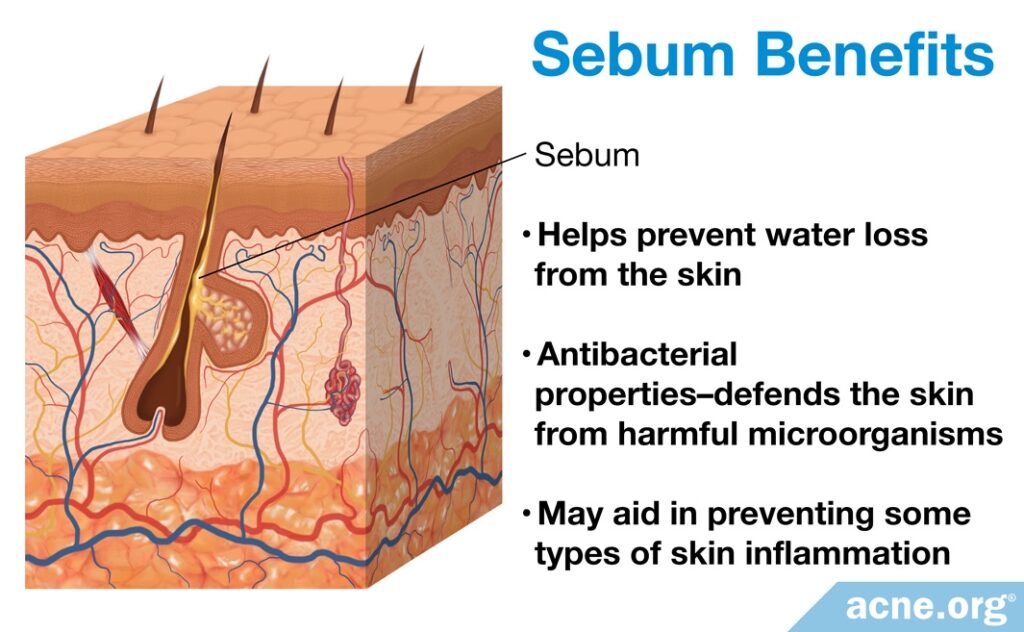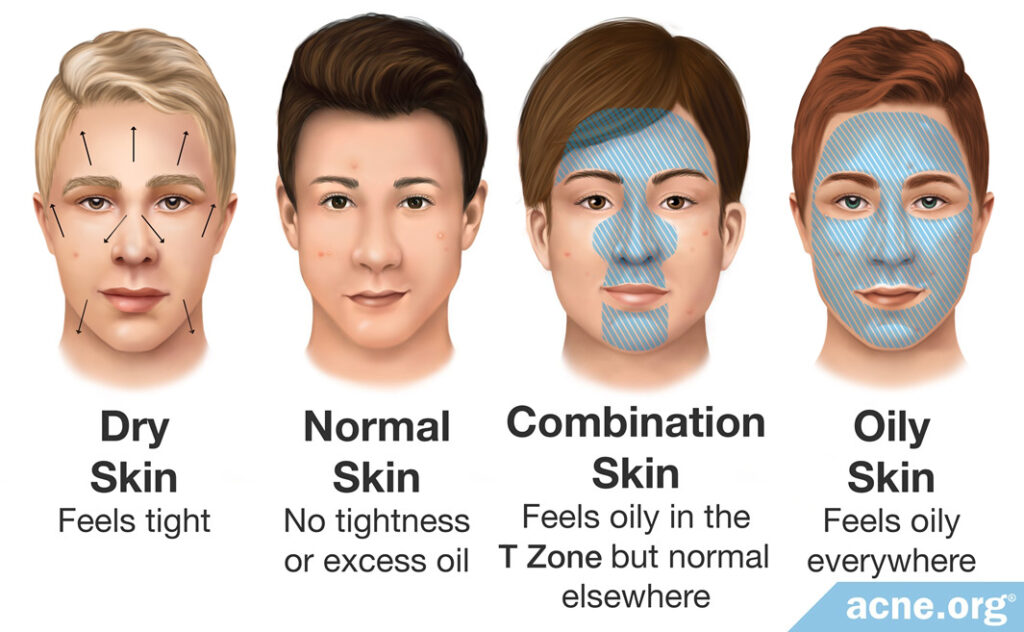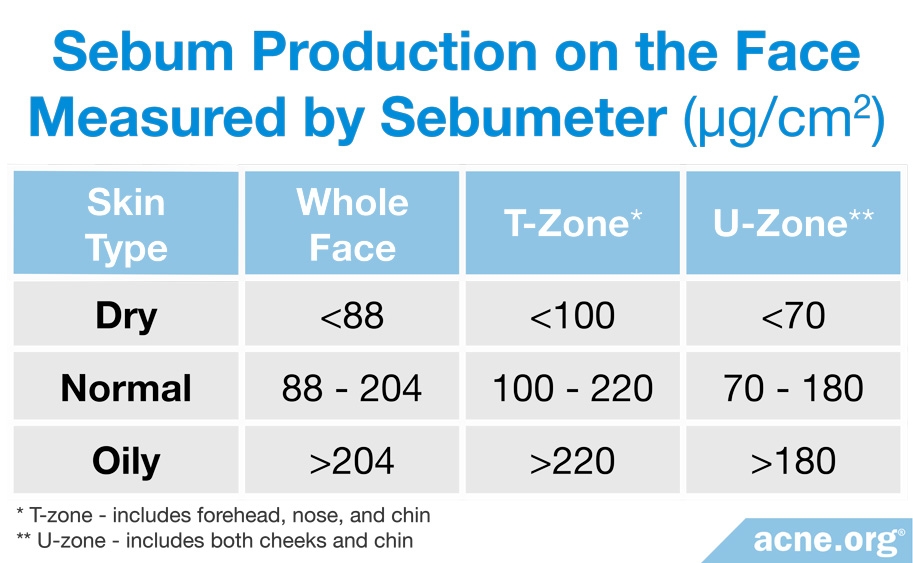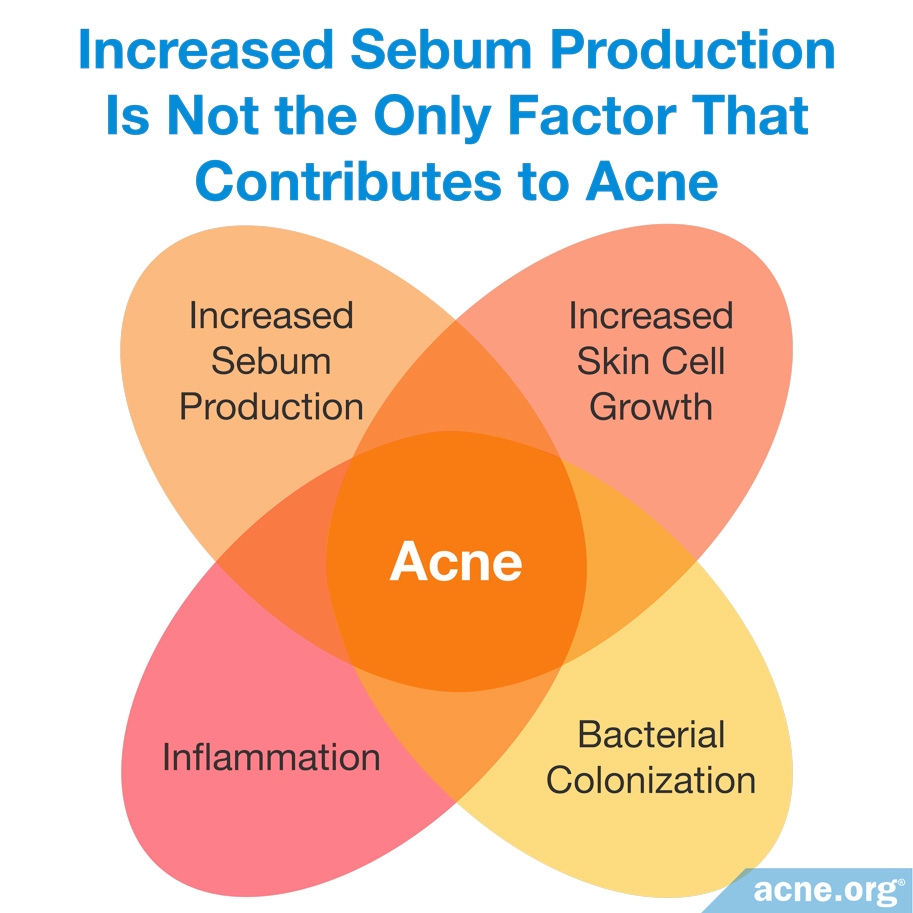Yes. People with Acne Usually Have Oilier Skin than People Without Acne.

The Essential Info
Skin oil is required for acne to form in the first place, and several studies have shown that patients with acne consistently produce a greater amount of skin oil than patients without acne. So the answer is yes, oilier skin is more likely to develop acne.
However, factors other than skin oil production, such as inflammation, bacteria, and increased skin cell growth also play a role in acne development.
Note: If oily skin leads to more acne, it might seem to make sense that drying out the skin will clear acne. But this is not the case. Skin that is balanced–neither dry nor oily–is easiest to keep clear. This is why when treating the skin for acne, if you are using a drying medication like benzoyl peroxide, moisturizing the skin after applying medication is essential.

The Science
- The Function of Sebum
- Skin Types
- Evidence That Oily Skin Is More Prone to Acne than Normal Skin
- Importance of The Chemical Composition of Sebum
- Sebum Is Not the Only Factor Involved in Acne Development
Human skin, all over the body but particularly on the face, is covered by an oil called sebum.
Sebum is produced by glands attached to each skin pore. After the glands produce sebum, it slowly makes its way up the pore and is released onto the surface of the skin.1
Humans produce different amounts of sebum and thus have different skin types, ranging from dry to oily.
Conventional wisdom suggests that oily skin is the skin type most prone to acne, and as we will see, scientific evidence backs this up. The oilier the skin, the higher the chance of developing acne.
The Function of Sebum

Sebum is not necessarily a bad thing. It helps prevent water loss from the skin, defends the skin from microorganisms, and can aid in preventing some types of skin inflammation.
However, too much sebum can lead to more acne, especially if the sebum has a skewed chemical composition which causes it to irritate the pore. Exactly how the composition of sebum contributes to acne is unknown, but as we’ll see, we do know that the more total sebum someone has, the more that person is usually susceptible to acne.
Skin Types

There are four major skin types:
- Dry
- Normal
- Combination
- Oily
Dry, normal, and oily skin are all pretty straightforward. They are what they are. However, people with combination skin have dry, normal, and/or oily skin in various areas on their face. The most frequent case with a combination skin type is that a person will have oily skin on their forehead, nose, and chin (called the T-zone) but have normal or dry skin on their cheeks.2
Expand to learn how skin oil is measured
How do you know what type of skin you have? Individual skin type is usually measured simply by subjective personal assessment. This means that a person decides on their own whether their skin looks and feels oily, dry, normal, or a combination of these types. This is not an accurate method, though. Opinions of skin oiliness may differ from person to person, and objective methods of assessment are needed for scientific research. As one prolific acne researcher stated, “…an individual’s feelings on the topic of facial sebum secretion are too subjective, and significant discrepancies exist between such subjective descriptions of facial skin type and objective measurements. Thus, facial skin type determinations should be performed using objective measuring devices and guidelines for skin typing.”2
Fortunately, there is an objective, scientific method of measuring skin oil amount. This is done with a device called a Sebumeter.3 This helps determine exact skin oiliness levels and is critical for scientific studies on skin oiliness. However, very few people ever have the opportunity to get a Sebumeter reading, so in the real world, determining your skin type really does come down to subjectivity.
The way a Sebumeter works is relatively straightforward. First, a translucent strip is pressed against the patient’s skin for 30 seconds. This strip will absorb sebum and become transparent. The more sebum the strip absorbs, the more transparent it becomes. The Sebumeter then measures the transparency level of the strip and translates this amount of transparency into something called the casual sebum level (CSL). The CSL is measured in micrograms per square centimeter (µg/cm2) and is used to define specific areas of the skin as dry, normal, or oily. The CSL ranges for each of these skin types in different facial areas are defined in the table below.2 If readings come back different on different areas on the face, that means someone has combination skin.

What Is the Evidence That Oily Skin Is More Prone to Acne than Normal Skin?
A number of studies have all strongly supported the connection between increased skin oil production and acne development.4-7 In other words, more skin oil really does mean more acne. However, the exact way in which sebum production causes acne is still unknown.
Expand to read details of studies

A study published back in 1983 in the Journal of the American Academy of Dermatology compared 12 participants with mild-to-moderate acne to another 12 other participants without acne. Both sets of 12 patients included people with similar ages and genders. The researchers determine the sebum excretion rate, which is the measurement of the amount of skin oil production, in each participant. As the researchers expected, they found that all the subjects with acne had a higher sebum secretion rate than the subjects without acne. In fact, there was a very strong correlation between acne incidence and high sebum excretion rate. This suggests that oily skin is more prone to acne than normal skin.
Furthermore, this study also found a link between acne severity and sebum secretion rate. Subjects with moderate acne had twice the sebum secretion rate of subjects with only mild acne.4

South Korean studies: A series of studies on the relationship between skin oiliness and acne have been published by South Korean researchers in recent years. In the first study, published in the British Journal of Dermatology in 2005, researchers determined the casual sebum level (CSL) of 46 female patients with acne and 46 female patients without acne by using a Sebumeter, as well as the skin type of all these patients. The CSL numbers were considerably higher in patients with acne than in the control group with no acne. This finding strengthened the case for oilier skin being more prone to acne.5

The second South Korean study was published in 2006 in Archives of Dermatological Research and was led by the same researcher as the study above. This study compared 23 females and 13 males with acne to a group of 23 females and 13 males without acne. The CSLs were determined on five regions of the face for each of these patients: the left cheek, right cheek, chin, nose tip, and forehead. Every area of the face had slightly higher CSL numbers in the patients with acne versus the patients without acne, with the exception of the nose tip. The nose tips had much higher CSL numbers in the acne patients when compared to the acne-free patients.6 Once again, these findings suggested that people with acne tend to have oilier skin than people without acne.

The same lead researcher also published more findings in 2013 in the Journal of the European Academy of Dermatology and Venereology from a study with a much larger sample size. This study examined the cases of 278 male and 636 female acne patients from 2004 to 2009. For each patient, the CSL values of their cheeks and their T-zone (the forehead, nose, and chin) were determined. The number of comedones (whiteheads and blackheads), inflammatory lesions, and total number of acne lesions, which was comedones plus inflammatory lesions, on each patient’s face was also counted. Just like in the previous studies, the researchers found a correlation between higher CSL values and the amount of acne. Specifically, higher CSL numbers, or more oiliness, were consistent with more inflammatory lesions. This held true for every area of the face – the cheeks, T-zone, and the entire face. Since this 2013 study utilized a larger sample size, these findings were considered more reliable than the previous studies above. The researchers concluded that the greater amount of skin oil a person has, the more likely they are to develop acne.7
One Study Found No Link Between Skin Oiliness and Chest and Back Acne
The studies discussed above primarily focused on skin oil and acne on the face. Interestingly, one study showed something slightly different when looking at acne on the trunk, meaning the back and chest. That study found no connection between sebum secretion and acne development on the skin of the trunk. In fact, in that study, patients with acne had lower sebum secretion on the trunk than on the face, even though they had acne in both locations.8 Exactly what this means is unclear, but there are a few possibilities to consider:
- Perhaps the skin of the trunk in people with acne does produce excess skin oil, but that skin oil stays in the pores, so measurements on the skin surface underestimate the amount of skin oil.
- Perhaps acne on the trunk is primarily caused by factors other than excess skin oil, such as inflammation or overgrowth of skin cells.
- Perhaps this one study is simply an outlier, and more studies looking specifically at body acne might find that acne on the trunk does tend to go hand-in-hand with excess skin oil.
We will need to see more research specifically on body acne to be able to draw conclusions on the role that excess skin oil plays in acne developing on the body.
Expand to read details of study

In 2015, the journal Dermatology published a study in which researchers looked at sebum secretion on the trunk in 35 females by using a Sebumeter. The researchers measured sebum secretion in 10 locations on the body: 7 on the back and 3 on the chest. They also compared the amounts of sebum on the trunk and on the face. The researchers found lower levels of sebum on the patients’ trunk than on the face, and saw no correlation between the amounts of sebum on the trunk and body acne.8 These results imply that while on the face, more sebum means more acne, the connection between sebum and acne may not be so clear-cut on the trunk.
The Chemical Composition of Sebum Is Also Important
So far, every study but one has found that increased skin oil production is associated with acne. However, more recent research is discovering that it’s not just about the amount of sebum, but its chemical composition as well.
In other words, it turns out that the specific fats making up sebum differ among different people, and certain types of fats are more likely to go hand-in-hand with acne.
In addition, people with acne of different severity also have different types of fats in their sebum. Scientists are now studying exactly how sebum composition affects acne as part of a newly emerged discipline called lipidomics.9,10
Sebum Is Not the Only Factor Involved in Acne Development

Sebum, inflammation, bacterial colonization on the skin, and increased skin cell growth all contribute to acne development.11 And all of these factors can influence each other. For example, increased sebum production can stimulate the growth of acne bacteria, and acne bacteria can help to trigger inflammation.
The exact sequence of these events is still unknown, and we do not yet understand the exact way in which each of these factors influences acne development. But one thing research agrees on is that oilier skin is more prone to acne.
References
- Zouboulis, C. C. Acne and Sebaceous Gland Function. Clin. Dermatol. 22, 360 – 366 (2004). https://www.ncbi.nlm.nih.gov/pubmed/15556719
- Youn, S. W., Na, J. M., Choi, S. Y., Huh, C. H. & Park, K. C. Regional and seasonal variations in facial sebum secretions: a proposal for the definition of combination skin type. Skin Res. Technol. 11, 189 – 195 (2005). https://www.ncbi.nlm.nih.gov/pubmed/15998330
- Kim, B.Y., Choi, J. W., Park, K. C. & Youn, S. W. Sebum, acne, skin elasticity, and gender difference – which is the major influencing factor for facial pores? Skin Res. Technol. 19, e45 – e53 (2013). https://www.ncbi.nlm.nih.gov/pubmed/22211382
- Harris, H. H., Downing, D. T., Stewart, M. E. & Strauss, J.S. Sustainable rates of sebum secretion in acne patients and matched normal control subjects. J. Am. Acad. Dermatol. 8, 200-203 (1983). https://www.ncbi.nlm.nih.gov/pubmed/6219137
- Youn, S. W., Park, S. W., Lee, D. H. Huh, C. H. & Park, K. C. Does facial sebum excretion really affects the development of acne? Br. J. Dermatol. 153, 919 – 924 (2005). https://www.ncbi.nlm.nih.gov/pubmed/16225600
- Kim, M. K., et al. Comparison of sebum secretion, skin type, pH in humans with and without acne. Arch. Dermatol. Res. 298, 113 – 119 (2006). https://www.ncbi.nlm.nih.gov/pubmed/16786345
- Choi, C. W., Choi, J. W., Park, K. C. & Youn, S. W. Facial sebum affects the development of acne, especially the distribution of inflammatory acne. J. Eur. Acad. Dermatol. Venereol. 27. 301-306 (2013). https://www.ncbi.nlm.nih.gov/pubmed/22176122
- Kim, B. R., Chun, M. Y., Kim, S. A. & Youn, S. W. Sebum secretion of the trunk and the development of truncal acne in women: Do truncal acne and sebum affect each other? Dermatology 231, 87-93 (2015). https://pubmed.ncbi.nlm.nih.gov/26022281/
- Camera, E., Ludovici, M., Tortorella, S., Sinagra, J. L., Capitanio, B., Goracci, L. & Picardo, M. Use of lipidomics to investigate sebum dysfunction in juvenile acne. J. Lipid Res. 57, 1051-1058 (2016). https://www.ncbi.nlm.nih.gov/pubmed/27127078
- Li, X., He, C., Chen, Z., Zhou, C., Gan, Y. & Jia, Y. A review of the role of sebum in the mechanism of acne pathogenesis. J Cosmet. Dermatol. 16, 168-173 (2017). https://pubmed.ncbi.nlm.nih.gov/28556292/
- Williams, H. C., Dellavalle, R. P. & Garner, S. Acne vulgaris. Lancet 379, 361-372 (2012). https://www.ncbi.nlm.nih.gov/pubmed/21880356
The post Is Oilier Skin More Prone to Acne? appeared first on Acne.org.
